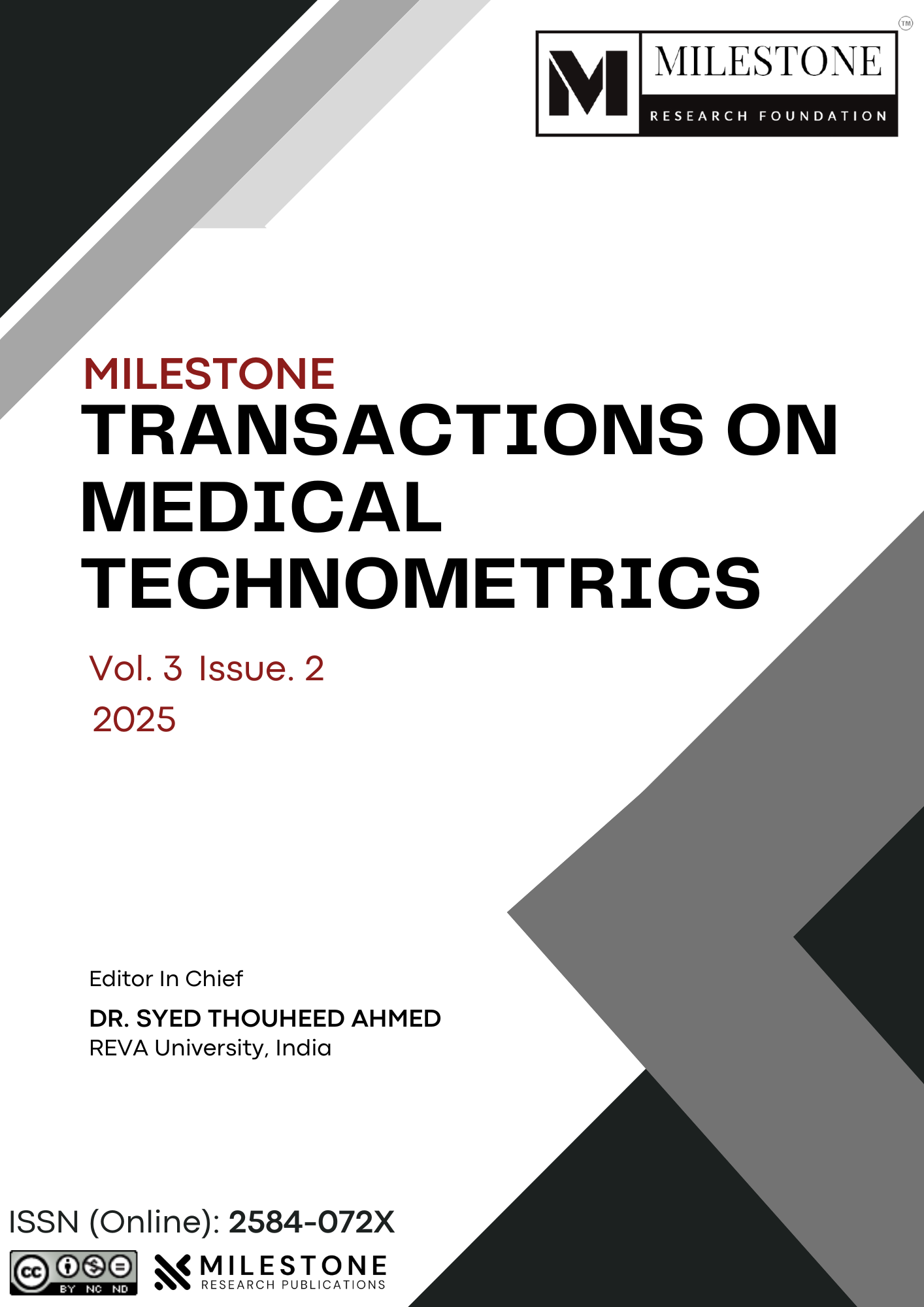Machine Learning Hybrid Models for Early Cervical Cancer Detection – A Comparative Study
Published 2025-05-30
Keywords
- AdaBoost,
- Cervical Cancer,
- Hybrid Models,
- Stacking Classifier,
- Logistic Regression Models
How to Cite
Abstract
Cervical cancer arises as a result of the uncontrolled growth of abnormal cells in the cervix, usually caused by chronic infection with high-risk types of Human PapillomaVirus (HPV). Early detection and prevention can be facilitated through regular screening and HPV vaccination. This study proposes an enhanced ML Hybrid Model focused on the early spotting of Cervical Cancer using the best available Machine Learning techniques. To solve a primary challenge in diagnosing accuracy and precision in Cervical Cancer, the model utilizes AdaBoost, XGBoost, Stacking Classifiers, and Logistic Regression. The Hybrid Model uses ensemble methods such as AdaBoost and XGBoost, which improves productivity by properly integrating poor learners. Stacking Classifiers increases accuracy even more by incorporating the predictions of several models while Logistic Regression adds interpretability as well as reliability to the results. Collectively, these approaches form a model that produces low false positive rates alongside low false negative rates for early detection of the disease. This study focuses on the effects that Machine Learning can have in treating advanced stages of healthcare issues especially relating to early detection of Cervical cancer. The combination of sophisticated computational methods with clinical data sets presents an effective, globally relevant solution to urgent health concerns.
References
- Menon, M. K. D., & Rodrigues, J. (2023). Efficient ultra wideband radar based non-invasive early breast cancer detection. IEEE Access, 11, 84214–84227.
- Kuo, Y.-H., Chen, Y.-S., Huang, P.-C., & Lee, G.-B. (2020). A CMOS-based capacitive biosensor for detection of a breast cancer microRNA biomarker. IEEE Open Journal of Nanotechnology, 1, 157–162.
- Brenes, D., Salcedo, M. P., Coole, J. B., Maker, Y., Kortum, A., Schwarz, R. A., Carns, J., et al. (2024). Multiscale optical imaging fusion for cervical precancer diagnosis: Integrating widefield colposcopy and high-resolution endomicroscopy. IEEE Transactions on Biomedical Engineering.
- Feng, X., Song, L., Wang, S., Song, H., Chen, H., Liu, Y., Lou, C., et al. (2019). Accurate prediction of neoadjuvant chemotherapy pathological complete remission (pCR) for the four sub-types of breast cancer. IEEE Access, 7, 134697–134706.
- Elsheakh, D. N., Fahmy, O. M., Farouk, M., Ezzat, K., & Eldamak, A. R. (2024). An early breast cancer detection by using wearable flexible sensors and artificial intelligent. IEEE Access.
- Jamil, R., Dong, M., Rashid, J., Orken, M., Pernebaykyzy, Z. S., & Ragytovna, M. K. (2024). High accuracy microcalcifications detection of breast cancer using Wiener LTI Tophat model. IEEE Access.
- Naseem, U., Rashid, J., Ali, L., Kim, J., Ul Haq, Q. E., Awan, M. J., & Imran, M. (2022). An automatic detection of breast cancer diagnosis and prognosis based on machine learning using ensemble of classifiers. IEEE Access, 10, 78242–78252.
- Ileberi, E., & Sun, Y. (2024). Machine learning-assisted cervical cancer prediction using particle swarm optimization for improved feature selection and prediction. IEEE Access.
- Youneszade, N., Marjani, M., & Pei, C. P. (2023). Deep learning in cervical cancer diagnosis: Architecture, opportunities, and open research challenges. IEEE Access, 11, 6133–6149.
- Asiedu, M. N., Skerrett, E., Sapiro, G., & Ramanujam, N. (2020). Combining multiple contrasts for improving machine learning-based classification of cervical cancers with a low-cost point-of-care pocket colposcope. In 42nd Annual International Conference of the IEEE Engineering in Medicine & Biology Society (EMBC) (pp. 1148–1151). IEEE.
- Anas, M., Ul Haq, I., Husnain, G., & Jaffery, S. A. F. (2024). Advancing breast cancer detection: Enhancing YOLOv5 network for accurate classification in mammogram images. IEEE Access.
- Khan, S., Nosheen, F., Naqvi, S. S. A., Jamil, H., Faseeh, M., Khan, M. A., & Kim, D.-H. (2024). Bilevel hyperparameter optimization and neural architecture search for enhanced breast cancer detection in smart hospitals interconnected with decentralized federated learning environment. IEEE Access.
- Ul Haq, A., Li, J. P., Saboor, A., Khan, J., Wali, S., Ahmad, S., Ali, A., Khan, G. A., & Zhou, W. (2021). Detection of breast cancer through clinical data using supervised and unsupervised feature selection techniques. IEEE Access, 9, 22090–22105.
- Noreen, N., Palaniappan, S., Qayyum, A., Ahmad, I., Imran, M., & Shoaib, M. (2020). A deep learning model based on concatenation approach for the diagnosis of brain tumor. IEEE Access, 8, 55135–55144.
- Rajendran, S., Rajagopal, S. K., Thanarajan, T., Shankar, K., Kumar, S., Alsubaie, N. M., Ishak, M. K., & Mostafa, S. M. (2023). Automated segmentation of brain tumor MRI images using deep learning. IEEE Access, 11, 64758–64768.
- Ahmad, S., & Choudhury, P. K. (2022). On the performance of deep transfer learning networks for brain tumor detection using MR images. IEEE Access, 10, 59099–59114.
- Metlek, S., & Çetıner, H. (2023). ResUNet+: A new convolutional and attention block-based approach for brain tumor segmentation. IEEE Access, 11, 69884–69902.
- Manogaran, G., Shakeel, P. M., Hassanein, A. S., Kumar, P. M., & Babu, G. C. (2019). Analysis. IEEE Access, 7, 12–19.
- Geeta, C. M., Raghavendra, S., Buyya, R., Venugopal, K. R., Iyengar, S. S., & Patnaik, L. M. (2018). Data auditing and security in cloud computing: Issues, challenges and future directions. International Journal of Computer, 28, 8–57.
- Geeta, C. M., Raju RG, S., Raghavendra, S., Buyya, R., Venugopal, K. R., Iyengar, S. S., & Patnaik, L. M. (2020). SDVADC: Secure deduplication and virtual auditing of data in cloud. Procedia Computer Science, 171, 2225–2234.
- TY, S., Ahmed, S. T., Mathivanan, S. K., Varadhan, S., & Shah, M. A. (2024). Trained neural networking framework based skin cancer diagnosis and categorization using grey wolf optimization. Scientific reports, 14(1), 1-10.

